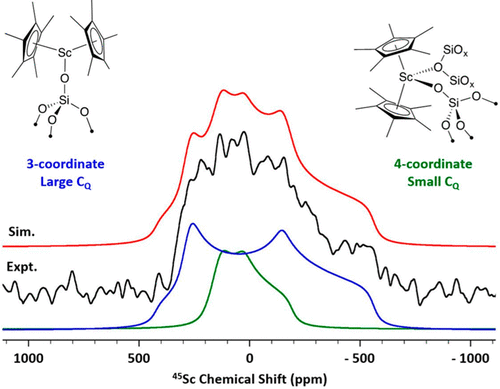当前位置:
X-MOL 学术
›
Organometallics
›
论文详情
Our official English website, www.x-mol.net, welcomes your feedback! (Note: you will need to create a separate account there.)
Solid-State 45Sc NMR Studies of Cp*2Sc–OR (R = CMe2CF3, CMe(CF3)2, C(CF3)3, SiPh3) and Relationship to the Structure of Cp*2Sc-Sites Supported on Partially Dehydroxylated Silica
Organometallics ( IF 2.8 ) Pub Date : 2020-02-26 , DOI: 10.1021/acs.organomet.9b00840 Damien B. Culver 1 , Winn Huynh 1 , Hosein Tafazolian 1 , Matthew P. Conley 1
Organometallics ( IF 2.8 ) Pub Date : 2020-02-26 , DOI: 10.1021/acs.organomet.9b00840 Damien B. Culver 1 , Winn Huynh 1 , Hosein Tafazolian 1 , Matthew P. Conley 1
Affiliation

|
Cp*2Sc–OR (R = CMe2CF3, CMe(CF3)2, C(CF3)3, SiPh3) was synthesized to determine how the alkoxide affects the quadrupole coupling (CQ) obtained from solid-state 45Sc{1H} NMR spectroscopy. These alkoxides are characterized by large (>29 MHz) CQ values, which are similar to CQ values obtained for Cp*2Sc–R (R = Me, Et, Ph) and Cp*2Sc–X (X = F, Cl, Br, I) but significantly larger than CQ values obtained for Cp*2ScX(THF). The NMR properties from these alkoxides were used to understand the NMR properties of Cp*2Sc-supported on silica partially dehydroxylated at 700 °C. This material contains two species from the solid-state 45Sc{1H} NMR spectra assigned to Cp*2ScOSi≡ (5a) and Cp*2Sc(OSi≡)O(SiOx)2 (5b). The solid-state 45Sc{1H} NMR spectrum of 5a is considerably broader than 5b, which relates to the magnitude of the quadrupolar coupling (CQ) in these two different sites. Density functional theory (DFT) optimized structures of Cp*2Sc–OR and small cluster approximations of 5a and 5b follow similar trends as the experimental CQ values for this family of organoscandium complexes. Analysis of the origin of CQ using DFT methods shows that σ- and π-bonding orbitals from the Sc–O bond in Cp*2Sc–OR and 5a are major contributors to CQ, whereas different orbitals contribute to CQ in 5b. These studies show that quadrupolar solid-state NMR spectroscopy can distinguish between surface sites on partially dehydroxylated silica.
中文翻译:

固态45个Cp的钪NMR研究* 2钪-OR(R = CME 2 CF 3,CME(CF 3)2,C(CF 3)3,SIPH 3)及关系的Cp *的结构2 SC-在部分脱羟基的二氧化硅上受支持的位点
合成了Cp * 2 Sc–OR(R = CMe 2 CF 3,CMe(CF 3)2,C(CF 3)3,SiPh 3),以确定醇盐如何影响由固相得到的四极偶合(C Q)。态45 Sc { 1 H} NMR光谱。这些醇盐的特征在于大的(> 29兆赫)C Q值,这是类似于C Q值的Cp *获得2钪-R(R =甲基,乙基,PH)1和Cp * 2钪-X(X = F ,Cl,Br,I),但明显大于Cp * 2获得的C Q值ScX(THF)。来自这些醇盐的NMR特性用于了解在700°C下部分脱羟基的二氧化硅上负载的Cp * 2 Sc的NMR特性。此材料含有从固体状态的两个物种45钪{ 1 H} NMR谱分配到的Cp * 2 ScOSi≡(图5a)和的Cp * 2钪(OSi≡)O(SIO X)2(图5b)。5a的固态45 Sc { 1 H} NMR光谱比5b宽得多,这与四极耦合的大小(C Q)在这两个不同的网站中。Cp * 2 Sc–OR的密度泛函理论(DFT)优化结构以及5a和5b的小簇近似值遵循与该有机scan络合物系列的实验C Q值相似的趋势。C的原点的分析Q使用DFT方法表明,从在的Cp *对SC-O键和σ-π-键轨道2钪-OR和5a中的主要贡献者至C Q,而不同的轨道有助于至C Q在图5b。这些研究表明,四极固态NMR光谱可以区分部分脱羟基二氧化硅的表面位置。
更新日期:2020-02-26
中文翻译:

固态45个Cp的钪NMR研究* 2钪-OR(R = CME 2 CF 3,CME(CF 3)2,C(CF 3)3,SIPH 3)及关系的Cp *的结构2 SC-在部分脱羟基的二氧化硅上受支持的位点
合成了Cp * 2 Sc–OR(R = CMe 2 CF 3,CMe(CF 3)2,C(CF 3)3,SiPh 3),以确定醇盐如何影响由固相得到的四极偶合(C Q)。态45 Sc { 1 H} NMR光谱。这些醇盐的特征在于大的(> 29兆赫)C Q值,这是类似于C Q值的Cp *获得2钪-R(R =甲基,乙基,PH)1和Cp * 2钪-X(X = F ,Cl,Br,I),但明显大于Cp * 2获得的C Q值ScX(THF)。来自这些醇盐的NMR特性用于了解在700°C下部分脱羟基的二氧化硅上负载的Cp * 2 Sc的NMR特性。此材料含有从固体状态的两个物种45钪{ 1 H} NMR谱分配到的Cp * 2 ScOSi≡(图5a)和的Cp * 2钪(OSi≡)O(SIO X)2(图5b)。5a的固态45 Sc { 1 H} NMR光谱比5b宽得多,这与四极耦合的大小(C Q)在这两个不同的网站中。Cp * 2 Sc–OR的密度泛函理论(DFT)优化结构以及5a和5b的小簇近似值遵循与该有机scan络合物系列的实验C Q值相似的趋势。C的原点的分析Q使用DFT方法表明,从在的Cp *对SC-O键和σ-π-键轨道2钪-OR和5a中的主要贡献者至C Q,而不同的轨道有助于至C Q在图5b。这些研究表明,四极固态NMR光谱可以区分部分脱羟基二氧化硅的表面位置。


























 京公网安备 11010802027423号
京公网安备 11010802027423号